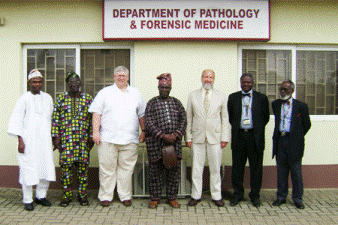Natural Resources, School of

Karl Reinhard Publications
Document Type
Article
Date of this Version
2008
Citation
Published in: Chaco’s Northern Prodigies: Salmon, Aztec, and the Ascendancy of the Middle San Juan Region after AD 1100, edited by Paul F. Reed (Salt Lake City: The University of Utah Press, 2008), pp. 86-95 & 389-427.
Abstract
Two fields of paleopathological investigation originated in the Southwest. Archaeoparasitology is the study of ancient parasite infection (Reinhard 1990, 1992b). It includes comparisons between time periods of single societies as well as comparisons of parasitism between different, contemporaneous cultures. For example, Fry (1980) compared Fremont and Anasazi parasitism, and also Archaic hunter-gatherer and ancestral Pueblo parasitism. All of these studies fall into the definition of archaeoparasitology.
By contrast, pathoecology is the reconstruction of relationships among behavior, environment, and disease organisms in the development of illness (Martinson et al. 2003; ReinhardandBuikstra2003; Reinhardet al. 2003; Santoro et al. 2003).1his field developed from the need for fine-grained analysis of prehistoric ecological and behavioral conditions to assess factors that affected disease. Pathoecological interpretation depends on archaeological information regarding parasitism, community size, trade patterns, water sourceS, subsistence practices, environment, medicinal use, and many other topics. Although the term is new, pathoecology developed over several decades. I view EI-Naijar et al.'s (1976) study of ancestral Pueblo anemia as the first pathoecology study. Perhaps the most advanced example of pathoecology is Stodder and Martin's (1992) multifactorial perspective on ancestral Pueblo disease. My study (Reinhard 1996) of the factors that affected parasitism at Antelope House and Salmon Ruin is another application of pathoecology.
Ancestral Pueblo communities have long been the focus of archaeoparasitology. Samuels (196S) developed the methods for helminth (parasitic worm) egg recovery with coprolites from Mesa Verde. Subsequently, Stiger (1977) provided the first intersite comparison analysis for sites on Mesa Verde. Fry and his colleagues conducted the first regional comparisons of parasitism, focusing on Canyon de Chelly and Glen Canyon (Fry 1977; Fry and Hal1197S, 1986). Fry (1977) also presented the first cross-cultural analysis of Archaic, ancestral Pueblo, and Fremont sites, and pioneered the comparison of parasitism among populations practicing different subsistence strategies. Building on this previous work, I have analyzed the diversity of helminths that parasitized ancestral Pueblo peoples (Reinhard 1985a, 1985b, 198sc, 1990; Reinhard et al. 1987). By 1985, archaeoparsitologists had identified eight species of helminth that infected ancestral Puebloans (Figure 1).
Aidan Cockburn's insight into the origins of disease influenced the development of pathoecology in the archaeoparasitology of ancestral Pueblo sites. Cockburn (1967, 1971) argued that the evolution of infectious diseases followed human evolution and the development of human cultures. Inspired by Cockburn, Reinhard (198Sa) compared the parasitic state of Colorado Plateau Archaic peoples to ancestral Pueblo an sites. He verified Cockburn's hypothesis that occasional infections in hunter-gatherers became major health hazards in agricultural populations. Reinhard (1988) presented anumberofpathoecological findings regarding the development of parasitic disease in ancestral Puebloans relative to earli~r hunter-gatherers. Parasitism was limited in hunter-gatherers due to small band size, band mobility, diffuse regional populations, and the presence of natural anti-helminthics (worm poisons) in hunter-gatherer diets. Huntergatherer parasitism was promoted by the consumption of uncooked meat and insects. Parasitism was promoted in ancestral Puebloan communities by contaminated water sources, concentrated populations, a more sedentary lifestyle, crowded (apartment-style) living conditions, establishment oflarge latrines, activities centered on water (agriculture), and activities that expanded wetlands (ineluding irrigation of all types).
Includes (volume) References.
Included in
Archaeological Anthropology Commons, Ecology and Evolutionary Biology Commons, Environmental Public Health Commons, Other Public Health Commons, Parasitology Commons


Comments
Copyright © 2008 The University of Utah Press.